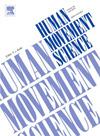针对特定领域的平衡训练可降低年轻人因滑倒而跌倒的风险:扰动训练的潜在替代方案
IF 1.9
3区 心理学
Q4 NEUROSCIENCES
引用次数: 0
摘要
背景外部环境干扰(如滑倒)占跌倒的 60%,并导致严重的健康相关后果。众所周知,扰动训练范例可以通过改善反应性平衡控制的两个关键方面(质心(COM)稳定性和肢体支撑)来降低与滑倒相关的跌倒风险。然而,扰动训练需要复杂的技术,很难在实验室外实施。本研究探讨了关键的反应性平衡机制是否也可以通过针对意志性和反应性平衡控制的更具临床可转化性的平衡训练(即特定领域平衡训练)来改善。方法 12 名年轻成人完成了一次特定领域平衡训练,并暴露于一次地面滑倒(S1-特定领域)。对照组(n = 12)在未接受训练的情况下接受 24 次地面滑行(S1-24-对照组)。在第一次(新颖的)滑倒时,我们比较了训练组和对照组(S1-特定领域组与 S1-对照组)的反应平衡能力(跌倒率和失去平衡率、稳定幅度 (MOS)、肢体支撑力)。我们还比较了 S1-特定领域组和对照组(S24-对照组)最后滑倒时的主要反应平衡结果。结果S1-特定领域组的向后失去平衡率低于 S1-对照组,同时滑倒后的 MOS 较高,臀部高度增加(即肢体支撑力增强)(p < 0.05)。这些改善与更靠前的 COM 位置、更大的 COM 前向速度和更小的滑移距离有关。滑倒后的 MOS 和臀部高度在 S1-特定领域和 S24-控制之间没有显著差异。特定领域平衡训练可提供与扰动训练类似的预防跌倒益处,而且更容易过渡到诊所、社区和家庭。本文章由计算机程序翻译,如有差异,请以英文原文为准。
Domain-specific balance training reduces slip-related fall risk in young adults: A potential alternative to perturbation training
Background
External, environmental perturbations (e.g., slips) account for >60% of falls and lead to severe health-related consequences. Perturbation training paradigms are known to reduce slip-related fall risk by improving two key aspects of reactive balance control: center of mass (COM) stability and limb support. However, perturbation training requires complex technology and is difficult to implement outside of the laboratory. This study examined if key reactive balance mechanisms could also be improved via more clinically translatable balance exercises targeting both volitional and reactive balance control (i.e., domain-specific balance training).
Methods
12 young adults completed a single session of domain-specific balance training and were exposed to a single overground slip (S1-Domain-Specific). The control group (n = 12) was exposed to 24 overground slips (S1–24-Control) without prior training. On the first (novel) slip, we compared reactive balance performance (rate of falls and loss of balance, margin of stability (MOS), limb support) between the training and control groups (S1-Domain-Specific vs. S1-Control). We also compared key reactive balance outcomes between S1-Domain-Specific and the final slip of the control group (S24-Control).
Results
There was a lower rate of backward loss of balance on S1-Domain-Specific than S1-Control, along with higher post-slip MOS and increased hip height (i.e., greater limb support) (p < 0.05). These improvements were associated with a more anterior COM position, greater COM velocity in the anterior direction, and reduced slip distance. Post-slip MOS and hip height were not significantly different between S1-Domain-Specific and S24-Control.
Discussion
A single session of domain-specific balance training improved key components of reactive balance control and could significantly reduce slip-related fall risk. Domain-specific balance training might provide similar fall prevention benefits as perturbation training, with easier transition into clinics, communities, and homes.
求助全文
通过发布文献求助,成功后即可免费获取论文全文。
去求助
来源期刊

Human Movement Science
医学-神经科学
CiteScore
3.80
自引率
4.80%
发文量
89
审稿时长
42 days
期刊介绍:
Human Movement Science provides a medium for publishing disciplinary and multidisciplinary studies on human movement. It brings together psychological, biomechanical and neurophysiological research on the control, organization and learning of human movement, including the perceptual support of movement. The overarching goal of the journal is to publish articles that help advance theoretical understanding of the control and organization of human movement, as well as changes therein as a function of development, learning and rehabilitation. The nature of the research reported may vary from fundamental theoretical or empirical studies to more applied studies in the fields of, for example, sport, dance and rehabilitation with the proviso that all studies have a distinct theoretical bearing. Also, reviews and meta-studies advancing the understanding of human movement are welcome.
These aims and scope imply that purely descriptive studies are not acceptable, while methodological articles are only acceptable if the methodology in question opens up new vistas in understanding the control and organization of human movement. The same holds for articles on exercise physiology, which in general are not supported, unless they speak to the control and organization of human movement. In general, it is required that the theoretical message of articles published in Human Movement Science is, to a certain extent, innovative and not dismissible as just "more of the same."
 求助内容:
求助内容: 应助结果提醒方式:
应助结果提醒方式:


